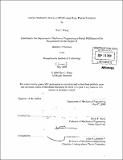Surface wettability studies of PDMS using flame plasma treatment
Author(s)
Wang, Xin C
DownloadFull printable version (3.795Mb)
Other Contributors
Massachusetts Institute of Technology. Dept. of Mechanical Engineering.
Advisor
David E. Hardt.
Terms of use
Metadata
Show full item recordAbstract
The flame plasma treatment studied in this thesis was able to oxidize the surface of Polydimethylsiloxane (PDMS) in a fraction of a second. It was found to be a much faster way to modify PDMS surface wettability than the current technologies. The surface wettability of Polydimethylsiloxane (PDMS) treated with flame plasma was studied. The surface wettability was characterized by contact angle measurements using water and a surface tension liquid as the probe liquids. Two experimental parameters were varied in this investigation: a) distance from the PDMS surface to the inner flame cone; b) the dwell time of the PDMS under the flame. The study concluded that the same surface wettability can be achieved through different combinations of distance and dwell time. The shortest dwell time needed to induce a contact angle of 100 or less on the treated PDMS surface in this experimental setup was approximately 0.18 second. This study also found that over treatment of the PDMS surface in the flame plasma yielded a reversal treatment effect and decreased the surface wettability. The flame plasma yielded uniform contact angle measurements within 15% across the PDMS surface. The recovery mechanism in the treated PDMS surfaces was dominated by the diffusion of untreated polymers from the bulk PDMS to the treated surface. The results from this investigation demonstrated the potential for the flame plasma treatment to be used in rapid manufacturing of PDMS microfludic devices.
Description
Thesis (S.B.)--Massachusetts Institute of Technology, Dept. of Mechanical Engineering, 2009. Cataloged from PDF version of thesis. Includes bibliographical references (p. 30).
Date issued
2009Department
Massachusetts Institute of Technology. Department of Mechanical EngineeringPublisher
Massachusetts Institute of Technology
Keywords
Mechanical Engineering.